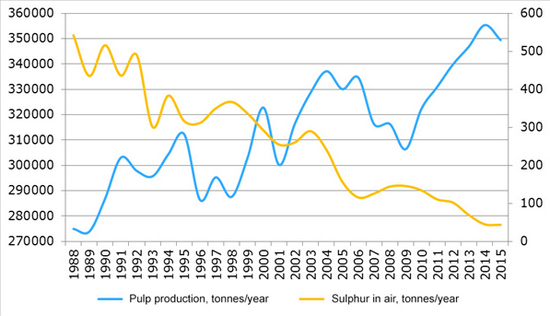Displaying items by tag: Iggesund Paperboard
A new cash flow to local farmers
Local farmers’ ability to sell biomass to Iggesund Paperboard’s paperboard mill at Workington will return over 1.5 million pounds annually to the local agricultural industry. The initiative has created a totally new source of income for close to 200 farms in Cumbria and Scotland. It was recently given Rushlight Bioenergy Award. The Rushlight Awards is a set of awards designed specifically to support and promote all the latest clean technologies, innovations, initiatives and deployment projects for businesses and other organisations throughout UK, Ireland and internationally.
In 2013 Iggesund invested in a biomass-fired combined heat and power plant for the primary purpose of being able to run its paperboard mill on renewable energy. Overnight the mill switched its energy supply from fossil natural gas to biomass, and thereby reduced its fossil carbon dioxide emissions by 190,000 tonnes a year, the equivalent to the annual emissions of about 65,000 cars. In conjunction with this move, the idea was born to offer local farmers the opportunity to grow and sell energy crops to Iggesund.
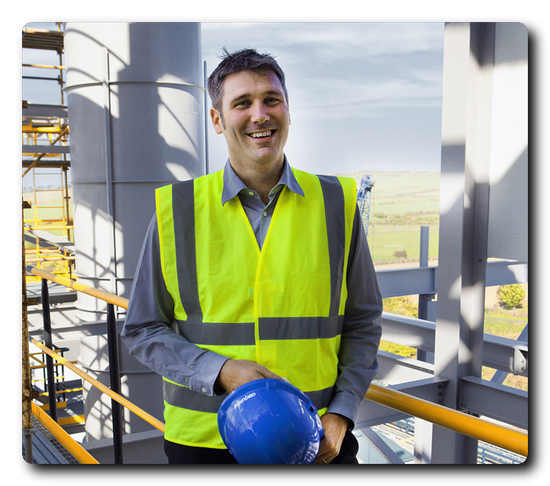 “Nearly 1.6 million pounds flows annually from our paperboard mill at Workington to the local farming community”, says Ulf Löfgren, Managing Director for the mill. In January 2019 the project was given the Rushlight Bioenergy Award.
“Nearly 1.6 million pounds flows annually from our paperboard mill at Workington to the local farming community”, says Ulf Löfgren, Managing Director for the mill. In January 2019 the project was given the Rushlight Bioenergy Award.
“It’s been an exciting journey. We began in a situation where many farmers were sceptical, as farmers often are. But gradually, as they saw our commitment and our calculations for how they could earn more from their less-fertile land, more and more of them have joined our project, which we call Grow Your Income,” explains Neil Watkins, Alternative Fuels Manager at Iggesund in Workington.
The goal was to bring in 25,000 tonnes of biomass from the farming industry. After five years, it is clear that this goal will be exceeded when all the contracted crops are ready to harvest.
Like so many other countries, the UK has an ageing rural population. Most farmers’ sons and daughters want to move to the big cities to become rock stars, computer geniuses or TV personalities. The older generation that remains must find less work-intensive crops which bring in a reliable income. Iggesund’s offer to the farming community involved helping with planting and also handling the harvest and transport to the mill. All these steps help to reduce the workload on the individual farms. Iggesund has also signed long index-linked contracts, which have helped to make the future income predictable.
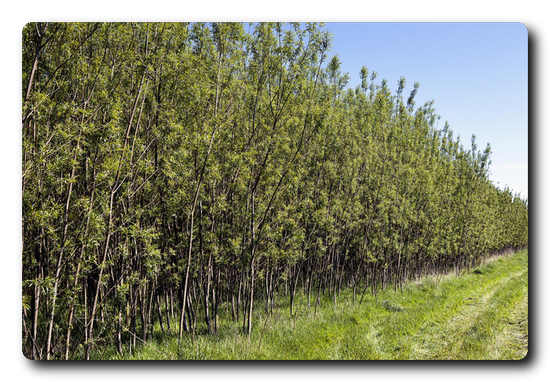
When the project began, DEFRA, the Department for Environment, Food & Rural Affairs, had made recommendations that parts of Cumbria have land highly suitable for energy crops. As the project developed, it became evident that the crops also help to counteract the effects of flooding and lead to greater biodiversity.
“Yet another advantage of energy crops – in our case Short Rotation Coppice willow – is that they give a good yield on less fertile land and do not lay claim to land that is better suited to food production,” Neil Watkins underlines.
Ulf Löfgren, Mill Director, who was involved in creating Grow Your Income, points out additional effects than just having ensured a supply of the fuel needed to run the mill.
“Cumbria and the parts of Scotland where we are active are dominated by agriculture,” he says. “Our interaction with farmers in working alongside them to grow energy crops, plus the fact that we meet with them at agricultural fairs and they come to us on study visits, has meant that we now have a far better-defined identity in the region.
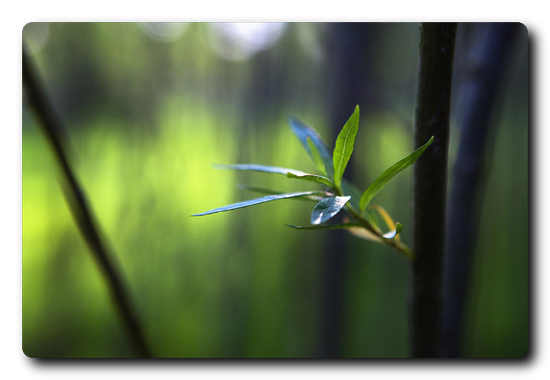
“In addition, we can also give ourselves a joint pat on the back for being a good example of the UN’s sustainable development goal 17, a partnership for achieving one of the other sustainable development goals. In this case, we have a collaboration between a large process industry and over 100 farmers to jointly reduce fossil emissions.”
Iggesund Paperboard is growing its own eight-hectare energy crop on the land surrounding the mill.
Iggesund
Iggesund Paperboard is part of the Swedish forest industry group Holmen, one of the world’s 100 most sustainable companies listed on the United Nations Global Compact Index. Iggesund’s turnover is just over €500 million and its flagship product Invercote is sold in more than 100 countries. The company has two brand families, Invercote and Incada, both positioned at the high end of their respective segments. Since 2010 Iggesund has invested more than €380 million to increase its energy efficiency and reduce the fossil emissions from its production.
Iggesund and the Holmen Group report all their fossil carbon emissions to the Carbon Disclosure Project. The environmental data form an integral part of an annual report that complies with the Global Reporting Initiative’s highest level of sustainability reporting. Iggesund was founded as an iron mill in 1685, but has been making paperboard for more than 50 years. The two mills, in northern Sweden and northern England employ 1500 people. www.iggesund.com
Packaging material a key issue for the climate
Switching material from plastic to paperboard can reduce a packaging’s climate impact by 99 per cent. For people who influence the choice of packaging material, this single choice can make the biggest climate impact during a product manager or designer’s entire professional career. That’s the conclusion of a study done by IVL Swedish Environmental Research Institute for Iggesund Paperboard.
The starting point was to study some of the commonest packaging types and compare the differences in climate impact depending on the choice of packaging material.
“There are tables giving carbon dioxide emissions per kilo of material, but when you compare real examples of packaging, you realise the great importance of the choice of material,” comments Johan Granås, Sustainability Director at Iggesund Paperboard.
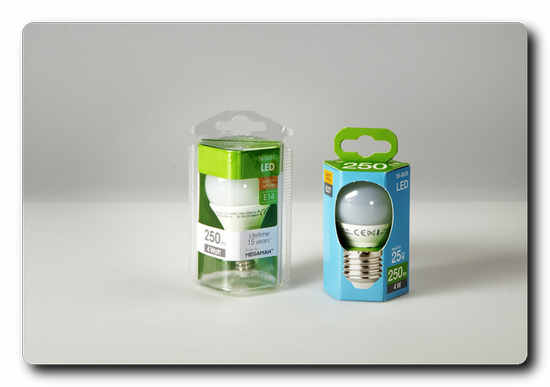
“Plastic is a fantastic material for many applications and we use it ourselves when producing paperboard for food packaging that needs a thin plastic barrier to protect its contents,” he adds. “But we believe that decision makers in the packaging industry must know about the effects of their choice of material.”
Packaging light bulbs in plastic or paperboard respectively is the most extreme example in the survey. By switching from plastic to paperboard, it is possible to reduce the climate impact of the packaging by 99 per cent. In the example that was most favourable for plastic, a paperboard carton containing 500 grams of pasta was compared with the corresponding amount of pasta packed in a thin plastic bag. The conclusion was that the plastic bag has a 3.25 times larger climate impact than the paperboard carton. This is despite the fact that the bag only weighs one-sixth as much as the carton and has significantly worse protective and stacking properties.
“There are masses of packagings that cannot be made in anything other than plastic today,” Johan Granås emphasises. “But there are also packagings that are made of plastic where it is easy to switch material without losing function at all – and it is logical to start there if we want to reduce packaging’s climate impact.”
For the paperboard packagings used in the study, climate data for Iggesund’s paperboard Invercote was used. For the plastic materials, IVL drew on data from the databases used for doing lifecycle analyses. None of the paperboard packagings used in the study is made of material from Iggesund Paperboard.
“This is a study that shows the climate impact of different types of packaging. The mandate to IVL was to be general. Neither they nor we know the climate data for each individual packaging. However, based on the recognised environmental databases, this definitely indicates the great importance of the choice of material,” Granås concludes.
IVL Swedish Environmental Research Institute was jointly founded in 1966 by the Swedish government and industry to do research into industry’s air and water management issues. Today IVL is an environmental institute that focuses on the interplay between environmental, economic and social perspectives.
Iggesund
Iggesund Paperboard is part of the Swedish forest industry group Holmen, one of the world’s 100 most sustainable companies listed on the United Nations Global Compact Index. Iggesund’s turnover is just over €500 million and its flagship product Invercote is sold in more than 100 countries. The company has two brand families, Invercote and Incada, both positioned at the high end of their respective segments. Since 2010 Iggesund has invested more than €380 million to increase its energy efficiency and reduce the fossil emissions from its production.
Iggesund and the Holmen Group report all their fossil carbon emissions to the Carbon Disclosure Project. The environmental data form an integral part of an annual report that complies with the Global Reporting Initiative’s highest level of sustainability reporting. Iggesund was founded as an iron mill in 1685, but has been making paperboard for more than 50 years. The two mills, in northern Sweden and northern England employ 1500 people.
Invercote and Incada - when paperboard pros get to choose
Iggesund Paperboard, which is part of the Holmen Group, has the two most valuable paperboard brands in Europe. That’s the conclusion of a brand survey done by the analyst firm Opticom International Research. Over 200 converters – companies that process paperboard into finished packaging – rank Invercote and Incada from Iggesund at the very top.
The survey encompasses converters in Germany, France, the UK, Italy, Spain, Switzerland, Belgium and the Netherlands in the packaging segments: pharmaceuticals & health care products, cosmetics & beauty, chocolate & confectionery, dry foodstuffs, frozen & chilled foods, and wines & spirits. The study has been done every second year since 2004 and Iggesund’s brands have consistently placed at the top.
“Every time we place highest in this survey we get confirmation that both our paperboard families offer what the market wants,” comments a satisfied Kenneth Nysten, Sales and Marketing Director at Iggesund. “Of course, it is particularly pleasing that the survey participants are converters, who make their living from transforming this white and lightweight paperboard into functional and elegant packaging.”
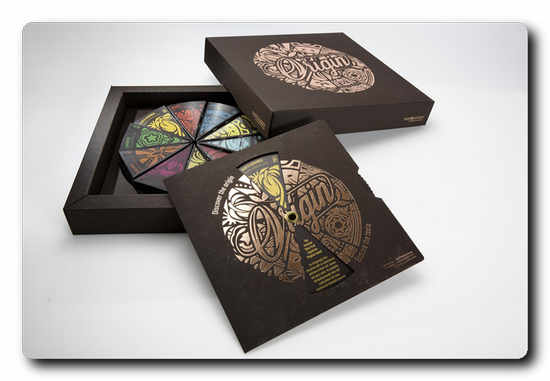 The Origin Box is made of three kinds of paper material, of which two, Invercote and Incada, are made by Iggesund Paperboard. Converter was Du Caju Printing & Packaging, Belgium.
The Origin Box is made of three kinds of paper material, of which two, Invercote and Incada, are made by Iggesund Paperboard. Converter was Du Caju Printing & Packaging, Belgium.
The survey also concludes that high quality and sustainability characteristics are becoming more and more important as selection criteria. Converters also have high expectations on properties such as printability, runnability in the conversion process, and folding properties – all of which both Invercote and Incada achieve with ease.
Iggesund and Stora Enso are perceived as leading the paperboard market with regard to sustainability, even though the majority of the respondents do not see any clear leader within the industry.
“The converters’ opinion, not least the fact that they single out runnability and product quality, reinforces our view that we are heading in the right direction. Their appreciation of our sustainability work is also important and a strong argument in favour of our products,” Nysten concludes.
Europe’s most valuable paperboard brands according to the survey:
1. Invercote (Iggesund)
2. Incada (Iggesund)
3. Tambrite (Stora Enso)
4. Ensocoat (Stora Enso)
5. Performa (Stora Enso)
6. BillerudKorsnäs (BillerudKorsnäs)
7. CKB (Stora Enso) NEW 2018
8. MetsäBoard Pro (Metsä Board) NEW 2018
9. Alaska Plus (International Paper)
10. MetsäBoard Classic (Metsä Board) NEW 2018
11. MetsäBoard Prime (Metsä Board) NEW 2018
Paperboard is replacing plastic to reduce climate impact
A number of global companies have replaced or are doing trials to replace the material in their gift cards – from plastic to paperboard. Sweden’s largest cinema chain, SF Bio, has taken the plunge and is now replacing all its cards.
“When our card supplier, Megacard, suggested we could make our gift cards from paperboard and thereby drastically reduce their environmental impact, it was self-evident to us to switch,” explains Anna Marcusson, product manager for gift cards at SF Bio.
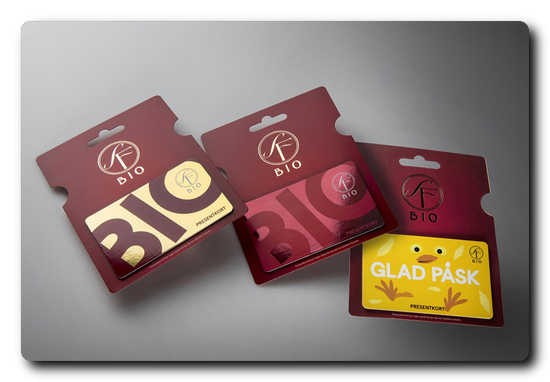 :“When we could have just as impactful cards in paperboard as in plastic we didn’t hesitate to switch – for the environment’s sake,” says Anna Marcusson, product manager for gift cards at SF Bio.
:“When we could have just as impactful cards in paperboard as in plastic we didn’t hesitate to switch – for the environment’s sake,” says Anna Marcusson, product manager for gift cards at SF Bio.
“In plain language, it means we’re phasing out the use of 10 tonnes of PVC a year by phasing out the plastic and replacing it with cards made of Invercote from Iggesund Paperboard,” she continues.
Replacing plastic with a non-fossil material is a clear trend, not least in the packaging industry. Switching from fossil plastic to an alternative material such as paperboard reduces companies’ climate impact. Changing an established infrastructure takes time, though, especially if it means that the packaging must be redesigned, the packing equipment modified or replaced, and the distribution from manufacturer to consumer is affected. The UK food company Iceland has attracted widespread attention with its pledges to eliminate plastic in its packaging within five years. Many people with packaging experience say five years is a fairly short time given the challenges faced by Iceland.
In light of these factors, the switchovers by IKEA and SF Bio have occurred very quickly, and there is reason to believe that many more companies will follow their example.
“Because the cards’ format is identical, it’s easy to make the switch. Apart from the actual production process for making the cards, very few other components of companies’ existing equipment need to be modified. So this is a very simple step to take compared with redesigning a plastic packaging solution, where complex and fully automated packing lines must be modified,” explains Johan Granås, Head of Sustainability at Iggesund Paperboard, who was closely involved in developing the solution that IKEA finally chose.
Another example of this packaging industry trend is Apple, where packaging developers are focusing on reducing the use of plastic. This is clear from Apple’s Paper and Packaging Strategy, which the company published in October 2017. Among other things, the report details how Apple succeeded in reducing the plastic content of the iPhone 7 packaging by 84 per cent compared with that of the iPhone 6s.
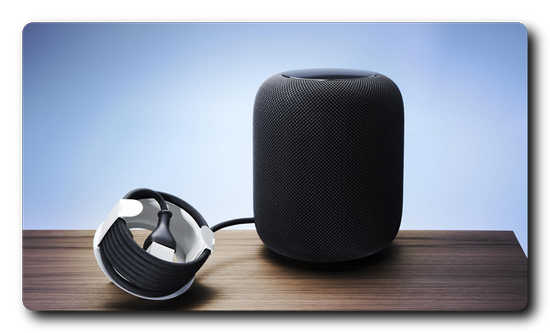 The cord holder for Apple’s smart speaker HomePod, which was launched at the beginning of 2018, is a clear example of the trend to replace plastic with paperboard. Ten years ago plastic would have been the obvious choice – but not today.
The cord holder for Apple’s smart speaker HomePod, which was launched at the beginning of 2018, is a clear example of the trend to replace plastic with paperboard. Ten years ago plastic would have been the obvious choice – but not today.
Apple’s smart speaker, HomePod, launched at the beginning of 2018, is a clear example of this approach. An incredibly complex paperboard construction with closures holds the speaker cord in place and there is also a setup to secure the plug.
“Ten years ago, any manufacturer would have solved this issue with plastic,” Granås says. “But now we’re seeing time and again how companies are investing strongly to create alternative solutions in paperboard – not only Apple but many, many others.”
Granås is careful to say that plastic is still an important material in both today’s and tomorrow’s packaging market. Traditional paperboard packaging for food often needs a plastic barrier to create a seal that protects against grease, moisture and aromas. Making the packaging’s construction out of paperboard and then creating the barrier with the thinnest possible plastic coating is already a good example of good materials management.
“The development of fossil-free plastic materials is happening very quickly and I predict we will soon have bioplastics with less and less fossil content, which will significantly reduce the climate impact of food packaging in particular,” Granås concludes.
Iggesund
Iggesund Paperboard is part of the Swedish forest industry group Holmen, one of the world’s 100 most sustainable companies listed on the United Nations Global Compact Index. Iggesund’s turnover is just over €500 million and its flagship product Invercote is sold in more than 100 countries. The company has two brand families, Invercote and Incada, both positioned at the high end of their respective segments. Since 2010 Iggesund has invested more than €380 million to increase its energy efficiency and reduce the fossil emissions from its production.
Iggesund and the Holmen Group report all their fossil carbon emissions to the Carbon Disclosure Project. The environmental data form an integral part of an annual report that complies with the Global Reporting Initiative’s highest level of sustainability reporting. Iggesund was founded as an iron mill in 1685, but has been making paperboard for more than 50 years. The two mills, in northern Sweden and northern England employ 1500 people.
Sustainability and availability won the race for Incada
After the Brexit referendum, Windles, one of the UK’s leading printers specialising in greeting cards and high end packaging, had cause to review its supply of paper and paperboard. After careful consideration, the company decided on the domestically produced paperboard Incada from Iggesund Paperboard, who have driven a powerful marketing campaign to create awareness of the product.
“But the choice was not only nationalistic. We tried to look at all aspects – price neutrality, availability, quality and everything that is included in the concept of total cost of ownership,” explains Windles’ Managing Director Bruce Podmore.
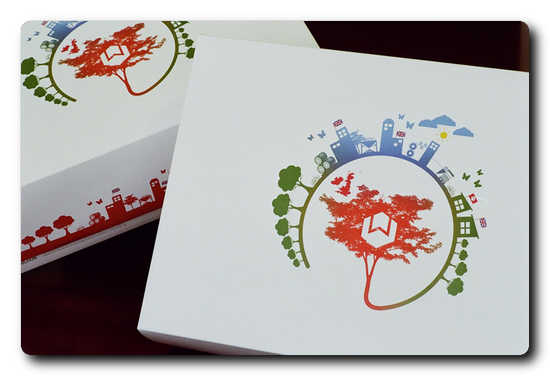 Windles, one of the UK’s leading printers specialising in greeting cards and high end packaging, chose Incada for both availability and excellent print result.
Windles, one of the UK’s leading printers specialising in greeting cards and high end packaging, chose Incada for both availability and excellent print result.
Windles moved into new premises in Thame, Oxfordshire, a couple of years ago. The factory was designed with long-term sustainability in mind. It is heated 80% with biomass, as the company extracts all the required energy from all the pallet wood it previously had to pay to get rid of. Nearby is another building designed to help the local bat population reproduce, a facility which Bruce Podmore calls “the bat cave”. Also on site is “the badger hotel”, a badger sett that was purpose built to house the local badgers.
“The most important aspects of our decision to choose Incada as our house paperboard were our desire to reduce our carbon footprint, plus Incada’s availability. With alternative manufacturers offering lead times of about 15 weeks, we would have needed a buffer of stocks to compensate for disruptions in the supply chains. That costs money, and more than we had expected,” Podmore continues.
“The lead times we can get for Incada with its production facility in Cumbria are significantly shorter than many of our previous supply arrangements,” he adds. “It’s also important not to underestimate the value of learning complete mastery of a material if it’s something you use often.”
Windles buys its paperboard via the merchant Antalis, and the collaboration with Iggesund was cemented when the two companies jointly visited the mill at Workington for a review of Incada’s performance and environmental properties.
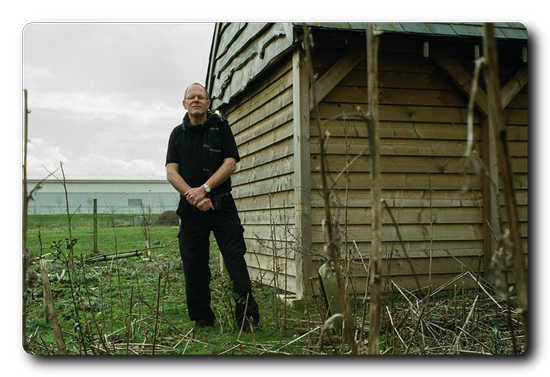 Bruce Podmore at “the bat cave”, a building designed to help the local bat population reproduce, a requirement for Windles present location.
Bruce Podmore at “the bat cave”, a building designed to help the local bat population reproduce, a requirement for Windles present location.
“For us it’s ideal to have a high-quality paperboard that is made nearby,” Podmore says. “Minimal shipments, short lead times and very good print results are quite simply a winning combination. And from a British perspective it’s also positive that we are buying input goods whose manufacture creates jobs in the UK.”
With regard to print properties, he says that Incada is one of the whitest paperboards on the market with an impressive surface smoothness, which also provides stability for creative cold foil, the process Windles is renowned for.
“Printing will be a dream where you don’t have to think about the yellowness of a board when designing. Glossy and matt finishes, and true baby blues and pinks are achievable without compensation – and there’s a huge improvement in lead times and fantastic service from the mill, plus we can guarantee the quality,” he says. “In addition, at Windles we are always striving to act in the most environmentally responsible way we can, which is why the fit of Incada being produced in the UK and at a mill using biomass for its energy is so important to us. Quite simply, we believe it is the right thing to do.”
Iggesund
Iggesund Paperboard is part of the Swedish forest industry group Holmen, one of the world’s 100 most sustainable companies listed on the United Nations Global Compact Index. Iggesund’s turnover is just over €500 million and its flagship product Invercote is sold in more than 100 countries. The company has two brand families, Invercote and Incada, both positioned at the high end of their respective segments. Since 2010 Iggesund has invested more than €380 million to increase its energy efficiency and reduce the fossil emissions from its production.
Iggesund and the Holmen Group report all their fossil carbon emissions to the Carbon Disclosure Project. The environmental data form an integral part of an annual report that complies with the Global Reporting Initiative’s highest level of sustainability reporting. Iggesund was founded as an iron mill in 1685, but has been making paperboard for more than 50 years. The two mills, in northern Sweden and northern England employ 1500 people.
Simple and minimalist with great complexity
In the world of packaging it is sometimes complicated to achieve something that looks simple, minimalist and elegant. The paperboard cartons for Jimmy Choo’s L’EAU that was launched in summer 2017 is a clear example of this. Its colour is pale pink apart from the brand, the name of the contents, and the fact that it is an eau de toilette. Yet the packaging has passed through twelve finishing stages.
The carton is made of Invercote from Iggesund Paperboard. Conversion is by the distinguished French printing company Draeger on behalf of Interparfums. The packaging is offset printed on both the inside and outside. The printing on the inside is in a pale pink shade, which creates the mood around the bottle. Externally the packaging has a blind-embossed snakeskin pattern plus two rows of text on the front. The outside is also laminated with soft touch film, matt varnished, and foil embossed with both silver film and holographic film.
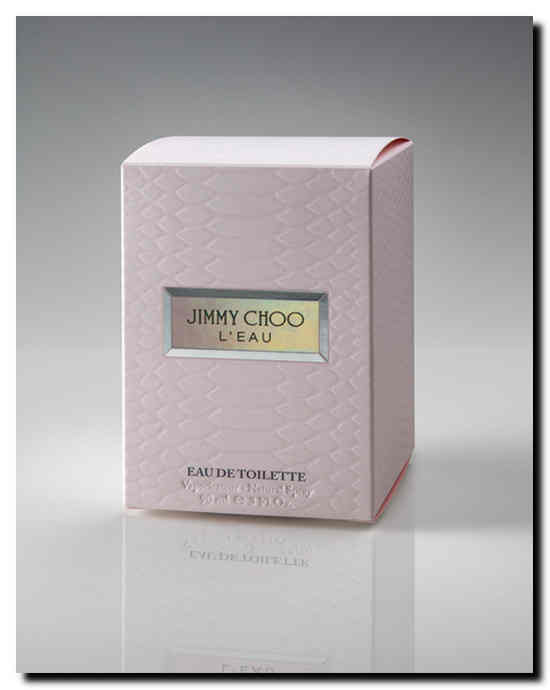 Jimmy Choo’s L’EAU is an example of a simple and minimalist design that requires complex processing. For the project the converters Draeger and licensee Interparfums chose to use Invercote from Iggesund Paperboard. ©Iggesund
Jimmy Choo’s L’EAU is an example of a simple and minimalist design that requires complex processing. For the project the converters Draeger and licensee Interparfums chose to use Invercote from Iggesund Paperboard. ©Iggesund
“Our choice to use Invercote G was motivated by the fact that its smooth surface allowed a very faithful reproduction of our design in terms of color and hot foil stamping. It also brings great embossing properties to achieve the impressive snakeskin pattern on the whole packaging” says Axel Marot, Supply Chain & Operations Director at Interparfums. For producers of advanced paperboard packaging involving many finishing stages, one paperboard property can be of critical importance to the end result: dimensional stability. This may not be the first thing people consider when choosing a material but experienced converters always include it in their calculations.
“If you have twelve finishing stages and get a misregister at stage ten, you don’t just lose the material but also all the work you invested prior to that,” explains Edvin Thurfjell, product manager for Invercote. “In today’s world of ever-increasing time pressure you also risk missing delivery times – and for many projects that just cannot be allowed to happen.”
In Invercote’s case the secret is a combination of a high proportion of long cellulose fibres from pine and spruce plus the sulphate process that extracts these fibres in a gentle way. In addition, the paperboard is constructed in several layers. This is not only important for dimensional stability; it also reduces the risk of cracks in creases compared with single-ply paperboard and paper. However, there is no simple measurement of dimensional stability that customers can find among the lists of specifications from paperboard manufacturers.
“For people who do read these specifications, two clues are high values for tearing strength and tensile strength. But I believe that a large proportion of our customers have discovered this strength from their own experience,” Thurfjell says.
As a product manager he believes, naturally enough, that people should pay more attention to their choice of material.
“As someone who is interested in packaging, I think it’s a pity when people compromise on their choice of material and endanger all the work that’s been invested before the production even starts. When people hire the best creatives and choose star photographers and models but don’t understand that the quality of the packaging material must be correspondingly high, then I do wonder if they’re thinking along the right lines.”
Iggesund
Iggesund Paperboard is part of the Swedish forest industry group Holmen, one of the world’s 100 most sustainable companies listed on the United Nations Global Compact Index. Iggesund’s turnover is just over €500 million and its flagship product Invercote is sold in more than 100 countries. The company has two brand families, Invercote and Incada, both positioned at the high end of their respective segments. Since 2010 Iggesund has invested more than €380 million to increase its energy efficiency and reduce the fossil emissions from its production.
Iggesund and the Holmen Group report all their fossil carbon emissions to the Carbon Disclosure Project. The environmental data form an integral part of an annual report that complies with the Global Reporting Initiative’s highest level of sustainability reporting. Iggesund was founded as an iron mill in 1685, but has been making paperboard for more than 50 years. The two mills, in northern Sweden and northern England employ 1500 people.
Finally – a plastic-free blister pack
One of the world’s most widely used forms of packaging – the blister pack – can now be made totally in paperboard. Two major benefits are reduced environmental impact and less consumer rage and self-injury. Blister packs are made to hang on a holder in the retail store and often consist of a paperboard backing plus a moulded transparent plastic front section to display the product to the consumer. The Norwegian converter Moltzaus’s ingeniously designed Cefapac improves both the pack’s environmental performance and its openability, and has already won awards.
“Our development work had two starting points – environmental impact and ease of opening,” explains Eirik Faukland, the packaging veteran in charge of R&D at Moltzau. “To get around the well-known problem of the extreme difficulty of opening plastic blister packs, the basic concept was to replace the plastic with paperboard. What’s unique with the Cefapac solution is that we chose to replace all the traditional creases with perforations, which gives the desired openability.”
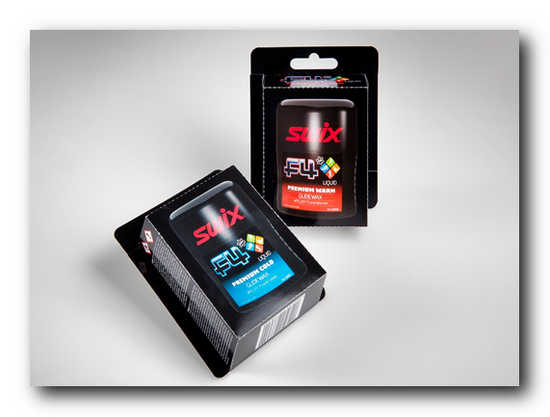 Ski wax from the global leader Swix in an easily opened, plastic-free pack. The pack could just as well hold a deodorant or skin cream from a manufacturer who wants to move from a fossil-based packaging material to a renewable, non-fossil-based one. © Iggesund
Ski wax from the global leader Swix in an easily opened, plastic-free pack. The pack could just as well hold a deodorant or skin cream from a manufacturer who wants to move from a fossil-based packaging material to a renewable, non-fossil-based one. © Iggesund
However, when perforations replace creases, the risk is that they cannot protect the pack’s contents well enough. The choice of which paperboard to use is therefore crucial.
“Invercote’s superior tear strength is a prerequisite for a good-quality pack,” Faukland says. “Both the strength and how it performs in the various stages of converting and filling are crucial.” He says another benefit is that in the packs Moltzau has produced so far, the perforations have allowed the customer to increase the speed of the filling lines compared with those using creased packaging blanks.
The world-leading manufacturer of ski wax, Swix, is currently packing some of its waxes in Cefapacs and plans to expand the trial. Other products in Cefapacs already on the market are dressings for wounds and non-prescription medicines. In the autumn of 2015 Cefapac was honoured with a Scandinavian packaging award, Scanstar, and in 2017 will receive the WorldStar award from the World Packaging Organisation.
As the pack’s designer, Eirik Faukland has also been warmly praised by representatives of the Swedish and Norwegian Rheumatism Associations, which represent rheumatism sufferers. The associations actively encourage the packaging industry to develop more easily opened forms of packaging.
Iggesund
Iggesund Paperboard is part of the Swedish forest industry group Holmen, one of the world’s 100 most sustainable companies listed on the United Nations Global Compact Index. Iggesund’s turnover is just over €500 million and its flagship product Invercote is sold in more than 100 countries. The company has two brand families, Invercote and Incada, both positioned at the high end of their respective segments. Since 2010 Iggesund has invested more than €380 million to increase its energy efficiency and reduce the fossil emissions from its production.
Iggesund and the Holmen Group report all their fossil carbon emissions to the Carbon Disclosure Project. The environmental data form an integral part of an annual report that complies with the Global Reporting Initiative’s highest level of sustainability reporting. Iggesund was founded as an iron mill in 1685, but has been making paperboard for more than 50 years. The two mills, in northern Sweden and northern England employ 1500 people.
Iggesund Paperboard
SE-825 80 Sweden
Tel: +4665028256
One of the world’s sustainability leaders
Iggesund Paperboard’s parent company, the Holmen Group, has gained a place on the Global 100, an index of the hundred most sustainable corporations in the world. Holmen ranks 21 and is the only company from the forest industry on the prestigious list.
The Global 100 list of the world's most sustainable corporations is announced each year at the World Economic Forum in Davos, Switzerland. The index has been published by the Canadian analysis firm Corporate Knights since 2005 and is based on an overall assessment of how a company handles issues concerning resource management, employees and financial management. Almost 5 000 companies have taken part in the assessment, with the hundred best featuring on the Global 100 index.
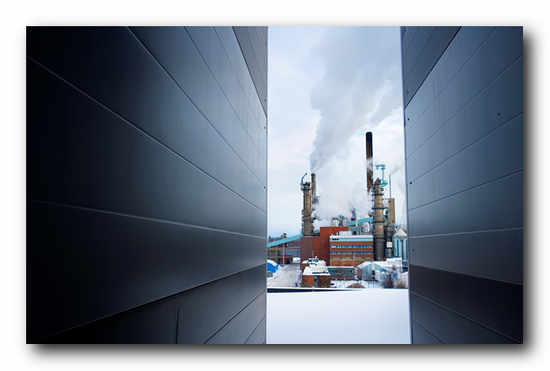
Iggesund Paperboard’s parent company, the Holmen Group is listed as number 21 on Global 100, a list of the world’s most sustainable companies.© Iggesund
"We are both proud and pleased to be on the Global 100 list as one of the most sustainable companies in the world. Holmen has taken a focused approach to sustainability issues for many years now. Being recognised and ranked highly by leading analysts is an acknowledgement of this work," says Lars Strömberg, Director of Sustainable and Environmental Affairs at Holmen.
"This ranking is the result of dedicated work and the strategic choices and investments we've made for the future, which have reinforced our sustainability profile. There is no doubt that the forest has good prospects as a raw material, especially amid a transition to a bio-economy in which products made from fossil raw materials are being replaced with renewable alternatives," comments Henrik Sjölund, President and CEO of both Holmen and Iggesund Paperboard.
Reaching the position on Global 100 is especially important for Iggesund Paperboard. The company’s products, Invercote and Incada, are targeting the high end packaging segment where a good track record in sustainability is a valuable asset.
“We have been ranked high on indices like the UN Global Compact Index, Carbon Disclosure Project, and now the Global 100. To repeatedly be acknowledged by these well renowned indices clearly shows that we are among the most sustainable companies in the world and is a recognition of the holistic and long term approach that characterizes our sustainability work”, says Johan Granås, Sustainability Communications Manager at Iggesund Paperboard.
Iggesund
Iggesund Paperboard is part of the Swedish forest industry group Holmen, one of the world’s 100 most sustainable companies listed on the United Nations Global Compact Index. Iggesund’s turnover is just over €500 million and its flagship product Invercote is sold in more than 100 countries. The company has two brand families, Invercote and Incada, both positioned at the high end of their respective segments. Since 2010 Iggesund has invested more than €380 million to increase its energy efficiency and reduce the fossil emissions from its production.
Iggesund and the Holmen Group report all their fossil carbon emissions to the Carbon Disclosure Project. The environmental data form an integral part of an annual report that complies with the Global Reporting Initiative’s highest level of sustainability reporting. Iggesund was founded as an iron mill in 1685, but has been making paperboard for more than 50 years. The two mills, in northern Sweden and northern England employ 1500 people.
A Christmas card with 44,000 variations
Iggesund Paperboard’s tradition of producing sophisticated Christmas cards continues. One says every single snowflake is unique and so will the Christmas card 2016 also be. This year Iggesund has created a snowflake that can be folded in many thousands of possible variations, from crystal white to winter blue colours.
The card consists of seven die-cut snowflakes with each side printed with a different pattern. These 14 variations can then be folded to create more than 44,000 different patterns. The design is the brainchild of German designer Peter Dahmen, who in recent years has specialised in digital finishing, often together with the Israeli print house Highcon. The snowflake created by the card’s recipient then encloses a card made of Invercote Metalprint 359 g/m2 with shades of cyan printed on metal foil and the traditional Christmas greeting on the reverse side.
“Digital finishing is an exciting field and Iggesund’s Christmas card is one of the most sophisticated commissions I’ve done in this area,” says Peter Dahmen. “In theory the project could be done using traditional die-cutting tools but with an edition of this size that would be much more expensive because then you have to remove the excess strips of paperboard manually.”
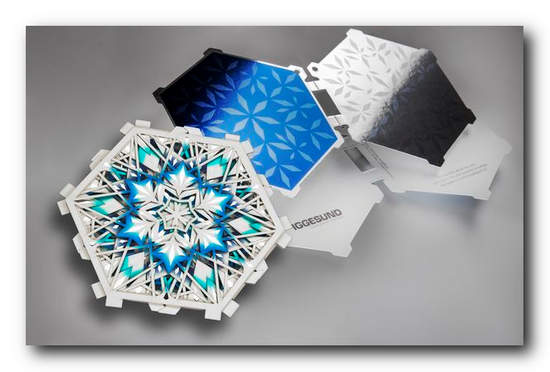
This year’s Christmas card made of Invercote from Iggesund Paperboard can be enjoyed in more than 44,000 different ways, offering the ultimate in versatility. © Iggesund
Highcon’s design engineer Yaron Eshel supported Dahmen in the creative process.
“I got the idea for the card the night before I was to fly to Israel,” Dahmen explains. “I was having trouble getting to sleep but when the idea came to me I had to jump out of bed and write it down before it went out of my head.”
During the flight the next day he refined the drawings on his iPad and showed them to Eshel on arrival.
“When he said it could be done using Highcon’s process, the basics fell into place.”
Dahmen has worked both with digital and traditional die cutting and creasing and is very familiar with all the techniques. But he says digital technology makes it possible to do more fine adjustments at the last minute.
“After you get the cutting tool and see how it functions, you may realise your idea won’t work quite the way you’d thought, or that a few more adjustments would raise the quality of the end result. Then digital technology gives me as a designer greater freedom because usually there’s no time to wait for a mechanical adjustment to the cutting tool.”
Iggesund Paperboard’s motive for producing sophisticated Christmas cards is not only to send an elegant greeting to its customers.
“We’re actively looking for new solutions and techniques, or innovative uses of traditional methods, that can inspire our customers around the world. The Christmas card is a printed sample which shows what people can achieve with our paperboards, Invercote and Incada,” explains Iggesund Paperboard’s project manager Anna Adler, who has about a dozen such cards to her credit so far.
Iggesund
Iggesund Paperboard is part of the Swedish forest industry group Holmen, one of the world’s 100 most sustainable companies listed on the United Nations Global Compact Index. Iggesund’s turnover is just over €500 million and its flagship product Invercote is sold in more than 100 countries. The company has two brand families, Invercote and Incada, both positioned at the high end of their respective segments. Since 2010 Iggesund has invested more than €380 million to increase its energy efficiency and reduce the fossil emissions from its production.
Iggesund and the Holmen Group report all their fossil carbon emissions to the Carbon Disclosure Project. The environmental data form an integral part of an annual report that complies with the Global Reporting Initiative’s highest level of sustainability reporting. Iggesund was founded as an iron mill in 1685, but has been making paperboard for more than 50 years. The two mills, in northern Sweden and northern England employ 1500 people.
A hundred-year perspective on sustainability
The brownish water and dead seabeds are gone. This year Iggesund Paperboard, manufacturer of the paperboards Invercote and Incada, can look back on a century’s unique performance record on sustainability. Iggesund Mill opened its first pulp mill in 1916, which was expanded to become an integrated pulp and paperboard mill in 1963.
“I’m proud to have the privilege of working for a company whose environmental efforts are characterised by both a long-term approach and a sense of responsibility,” comments Anna Mårtensson, Environmental Manager at Iggesund Paperboard’s Swedish production facility, Iggesund Mill. “Today our environmental impact is almost non-existent compared with the situation just over 50 years ago.”
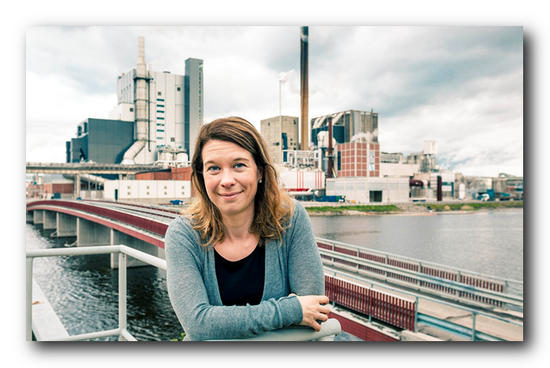
“From the 1960s and onwards we have steadily reduced our local environmental impact even though our production has increased,” comments Anna Mårtensson, Environmental Manager at Iggesund Paperboard’s Swedish production facility, Iggesund Mill. “Iggesund has every reason to be proud of this development as well as the fact that the mill now runs almost exclusively on fossil-free energy.” © Iggesund
When Iggesund built its first pulp mill in 1916, environmental legislation did not exist and companies were basically free to release fibre waste and chemicals into the air and water. During the mill’s first 50 years this caused a significant negative effect on the local environment. The first emissions limits were set in 1963, symbolically the same year that biologist Rachel Carson’s famous book about the influence of pesticides on nature, Silent Spring, was published and became the alarm clock that laid the foundation of today’s environmental movement.
“By the mid-1960s the combined emissions of process chemicals and cellulose fibres had turned the seabed around the mill into a desert,” Mårtensson continues. “The water smelled bad and was a brownish colour. Sensitive species at the top of the marine ecosystem’s nutrient chains had disappeared from the mill’s vicinity.”
Since the 1960s the mill’s effect on the local environment has continually been improved, driven by both economic and environmental demands. Today’s processes make more efficient use of the timber raw material, leading to a better use of resources and less release of organic material. Today having chemical emissions at the levels of the 1950s would be inconceivable; instead, more than 99 per cent of the process chemicals are recycled. Since the 1970s, Iggesund’s water purification measures have been built up into a three-stage process: mechanical, biological and finally chemical purification almost identical to that used to produce drinking water.
“Experts say the solution we have at Iggesund Mill is the best available technology,” Mårtensson adds. “Above all, it has radically reduced our emissions of sulphur and phosphorus, which are particularly important since our water goes out into the Baltic Sea, which is threatened by eutrophication.”
The mill’s airborne emissions have developed in the same direction – the levels of acidifying sulphur or eutrophying nitrogen are down to levels where their local environmental impact is hard to document.
“People can catch edible food fish in the water surrounding the mill,” Mårtensson says. “Using chemical analysis it is impossible to distinguish those fish from fish caught in reference areas far from industrial sites. We are very pleased to see how species like sea eagles and seals, which had disappeared from near the mill, have now returned.”
Sulphur emissions are one example of how the systematic environmental work has developed over time. In 1988 Iggesund Mill emitted 1.98 kilos of sulphur per tonne of pulp produced. Today’s emissions are just over six per cent of that, at 0.13 kilos per tonne. The corresponding value for the total amount of sulphur emitted per year has gone down from 540 annual tonnes to about 44 annual tonnes. This means that total sulphur emissions have fallen by 92 per cent despite a 25 per cent production increase over the same period.
In the past five years Iggesund Paperboard has also invested SEK 3.4 billion (EUR 360 million, GBP 225 million) to make its facilities in Sweden and the UK almost entirely fossil free by switching the energy source at the mills in Iggesund and Workington to bioenergy.
In the summer of 2016 Iggesund applied for a new permit for its operations. As a first step the company wants to increase its pulp production by 40,000 annual tonnes. In a later step, Iggesund Mill wants to increase its pulp production by another 40,000 tonnes and its paperboard production from today’s 400,000 tonnes to 450,000 tonnes per year.
“We’re now starting discussions with the authorities and I believe we have a number of good arguments going into the negotiations,” Mårtensson concludes. “Not least because we can point to half a century of continual improvements.”
